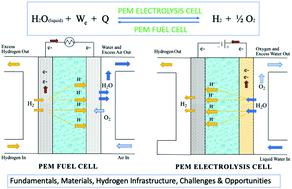当前位置:
X-MOL 学术
›
Energy Environ. Sci.
›
论文详情
Our official English website, www.x-mol.net, welcomes your feedback! (Note: you will need to create a separate account there.)
PEM Fuel cell and electrolysis cell technologies and hydrogen infrastructure development – a review
Energy & Environmental Science ( IF 32.5 ) Pub Date : 2022-04-26 , DOI: 10.1039/d2ee00790h Yun Wang 1 , Yiheng Pang 1 , Hui Xu 2 , Andrew Martinez 3 , Ken S. Chen 4
Energy & Environmental Science ( IF 32.5 ) Pub Date : 2022-04-26 , DOI: 10.1039/d2ee00790h Yun Wang 1 , Yiheng Pang 1 , Hui Xu 2 , Andrew Martinez 3 , Ken S. Chen 4
Affiliation

|
Polymer electrolyte membrane (PEM) fuel cells or PEMFCs and PEM electrolysis cells or PEMECs are two closely related electrochemical devices having a similar structure: a PEM with catalyst layers (CLs) coated on its surfaces, flow fields, and bipolar plates (BPs). Both systems work at low temperatures (e.g. ∼60–80 °C) and can operate free of CO2 emissions. The PEMFC efficiency can reach as high as 65% with water as the only byproduct when using hydrogen as the fuel. PEMFCs have been considered for stationary, transportation, and portable applications. Several PEMFC products are commercially available, including back-up power and fuel cell electric vehicles (FCEVs). As of May 2021, over 10 000 FCEVs were sold or leased in the U.S. and 48 fuel cell electric buses (FCEBs) currently operate in California. More than 3520 FCEVs and 22 FCEBs were sold or leased in Japan up to 2020 and China has more than 6000 FCEVs. The cost and the lack of a hydrogen infrastructure are the two main barriers to the worldwide deployment of PEMFCs. Currently, a PEMFC stack costs about $75 per kW at high volume production and its CLs account for over 40% of the overall cost due to the employment of precious platinum-group metals (PGMs) as catalysts. For FCEVs to be competitive cost-wise, the ultimate goal is $30 per kW for light-duty FCEVs and $60 per kW for heavy-duty FCEVs. Another challenge that prevents FCEVs from widespread application is that only a few hundred hydrogen refueling stations (HRSs) are available in the world. To help overcome this challenge, Japan has set a target of building 320 stations by 2025 and 900 by 2030. Europe has a roadmap of achieving 1500 stations by 2025. China has over 40 HRSs and has been reported to have invested $17 billion dollars in hydrogen infrastructure. PEMECs operate in the reverse process of PEMFCs, i.e. hydrogen production through water splitting using electrical energy, and provide a promising source of renewable hydrogen to supply the fueling infrastructure. They have been successfully commercialized with power varying from a few kW to multiple MW and efficiency around 60–80%. As of 2019, over 14 MW of PEMECs have been installed or are underway across the U.S. The cost of producing hydrogen via PEMECs, which is currently at about $4–6 per kg, has been a limiting factor that prevents large-scale deployment and application. The U.S. DOE has recently set a target to achieve $1 per kg within one decade through the Hydrogen Shot initiative. The objectives of this review are three-fold: (1) to present the current status of PEMFC and PEMEC technologies and their ongoing development, along with the hydrogen infrastructure, (2) to describe the similarities and differences in PEMFC and PEMEC structures, materials, and fundamentals, and (3) to outline the major challenges and opportunities in the widespread deployment of PEMFCs and PEMECs and hydrogen infrastructure development.
更新日期:2022-04-26



























 京公网安备 11010802027423号
京公网安备 11010802027423号